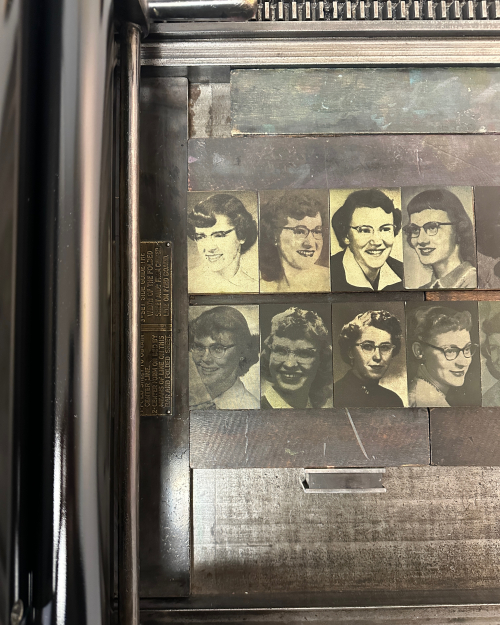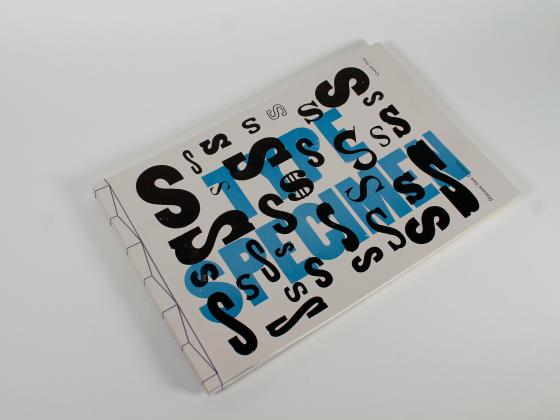More than 400 cases of metal and wood letters line the shelves of Montana State University’s letterpress studio.
The pieces of type, made from carving letters into wood blocks or by casting metal molds, range in size from the length of a pinky finger to 8-inch wooden letterforms. They are inked and pressed onto sheets of paper to form sentences and designs.
Letterpress art formed the basis of modern graphic design, from the first Chinese woodblock-printed text to the popularization of movable metal type in 15th century Europe. Artists at MSU have access to one of the largest type collections in the state, with some pieces dating back to the 1850s, said Ashley Fuchs, associate professor in graphic design for the School of Art.
“If this type could talk, it would have a lot of stories,” she said.
This academic year, Fuchs and her students printed each typeface in the collection onto hand-set artist books. Such books celebrate the artistry of how the book is made more than the physical book that’s produced, she said.
The books — filled with specimen pages showcasing typefaces for creative and educational purposes — put a creative spin on chronicling type by font style, size, origin and location in Haynes Hall’s Courier Press studio. Sales of the books, titled “Type Specimen M” and “Type Specimen S,” will help fund student educational trips to artist book fairs across the country.
“Organizing the collection is so important to preserve knowledge of what we have and acknowledge where it came from,” Fuchs said.
“Type Specimen M” documents MSU’s metal type collection. Fuchs and her students hosted workshops for 70 attendees to devise themes for each page over the course of four years. Topics range from contradictory food combinations, such as “SweeTARTS crumbled on pizza,” to “the vocal improvisation of scatting in jazz” and “commentary on pop culture.”
“These typefaces are vessels for a wide variety of opinions or historical time frames,” Fuchs said. “What individual letters can form together as a group and what they can say is a really interesting concept.”
Rylee Dunn, who graduated from MSU in 2021 with a bachelor’s degree in graphic design, helped Fuchs create the metal type book and led community workshops after taking the junior-level letterpress course. She said she enjoyed collaborating with other artists on a research-driven design project, working on a “living map of history” and merging it with the modern risograph printer. MSU’s risograph printed colored designs on transparent sheets overlaying the pages of historic letterforms.
As an added bonus, Dunn said it was impactful to see her name printed in the credits of a resource that art students will use decades from now.
“I remember as a young girl having the dream of being an artist ending up in a history book,” she said. “In a roundabout way, that dream has kind of been fulfilled.”
Dunn is currently a freelance graphic designer in Bozeman with previous experience in apparel design and development. Even though she has graduated, she still enjoys printing type by hand without the option to “undo.” It is important for modern designers to connect with historical processes to understand the thought and skill behind their work, she said.
Providing readers with a glimpse into the handmaking experience, “Type Specimen S,” documents MSU’s wooden type collection. For example, crackly wood type from a clothing company in Boston dates to about 1857, called a “twofer” for having both a letter and an image carved into opposite sides of a wooden block.
Jason Rigg, a senior at MSU studying graphic design, helped print the book’s cover and will assist Fuchs in her latest project, “Type Specimen U,” to conclude the “MSU” book trilogy. The printing process is nearly complete and features MSU’s halftone portrait collection, in which photographs are developed onto metal sheets and placed onto wooden blocks for printing, he said.

Nearly all the portraits can be traced to Park High School’s senior class of 1955 in Livingston. Most images were unidentified, but Fuchs matched an obituary to a Livingston man’s halftone portrait, which displayed his name in faded cursive. Scouring digitized yearbooks from the town’s historical society, Fuchs then identified the man’s entire graduating class.
Rigg likens the discovery process to a treasure hunt. He helped organize and identify pieces of the portrait collection as part of an independent study with Fuchs.
While initially wary of the letterpress — Rigg is dyslexic, and letters are carved into pieces of type so they appear backward — he quickly fell in love with the medium, which he said is a combination of Lego and art.
“Now it’s my favorite thing in the world,” he said. “I would live in a letterpress studio if I could.”
Last summer, Rigg interned with Hatch Show Print, one of oldest print shops in Tennessee, where two MSU School of Art alumni work full time. He produced designs for six clients, including restaurant chain Raising Cane’s and performance artists Pat Benatar and Luke Bryan.
Fuchs, who hangs a “Print nerd for life” poster on her MSU office door, said she feels a deep sense of pride from instructing the next generation of letterpress designers and “carrying the baton forward.”
“I know I’m not going to be here forever, and MSU’s studio will outlast me. The materials will outlast me,” she said. “But I’m hopefully contributing to the larger sense of conserving this craft and this shared history.”
By:



